Life is a Journey
As we journey through the seasons, their rhythms and qualities, we come to understand the challenges and joys of life. This course explores times of change as expressed in the outer world and their reflection in our own lives.
Samhain Solstice – Imbolc threshold
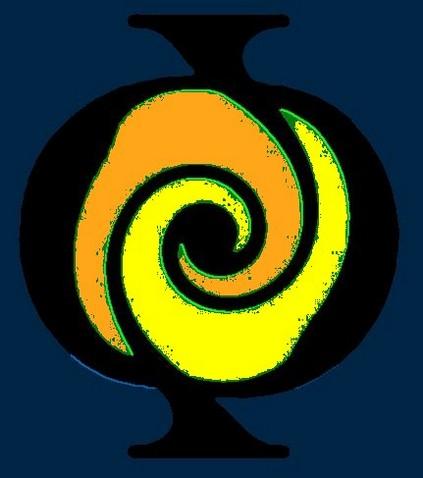
Aligning the soul
We humans transport flesh and bone bodies in our daily journeys and yet there is another, intangible, contribution to our experience of our presence on earth. Most people have an awareness of something else about themselves. Many call it the soul. Words cannot be found to define what this 'soul' is. It enters our consciousness in those occasions of unreality, times when we act intuitively. It seems it can only be experienced within the knowledge that 'I am alive'. We may be awake or asleep, but it is as if the soul is continually there, watching over our functioning whilst on earth. How often has it occurred that you 'met someone before' when being introduced to a new acquaintance. You may not have met before face to face but there is something about the person that is familiar, that connects you to them. What is this?
Philosophers suggest that we exist in many dimensions and realms, scientists theorise about time, linear, cyclical and eternal, theologists offer us a connection to the Divine. Ideas evolve and change, the land alters from day to day, we move from town to town and feel the different energies, Yet at the threshold, between Samhain and Imbolc or at any place of balance, there is neutrality. This goes beyond peace, harmony, love, war, discord and hate. Words might describe it as the heart of the matter, our essence, it is the quality of our 'being' and it connects us to others and the world around us. A connection that brings neither benefit nor harm.
It is probably easier to define neutrality by what it is not rather than what it is. It is not passive or active, but has full awareness, such total knowing of situations and surroundings that it can step aside and be non involved in the emotional, mental, physical and spiritual energy attachments. Neutrality is an energy of unquestioning acceptance. Once this is understood you know you can go anywhere any time with no drama.
In the darkness a light is shining
And so, in aligning the soul, we feed it with knowledge and experiences. Enjoy the beautiful sunrise and sunset that occurs at this time of year. Golds and pinks suffuse grey blue clouds with promise and hope for another warmer, brighter, longer day. We are leaving the restrictions of the Samhain darkness and entering into the light of Imbolc – the stirring in the belly.
The Goddess Brigid is brightening the earth realm. Her gift with the dawn on 1 February is the dew that forms as she travels across the land, drawing in her season. We welcome her and collect the dew, with its wonderful energy and healing properties. We shall use it during the year to enhance our lives, physical and spiritual.

Have you considered and valued all the darkness in your life over the last few months? You might like to do this review in order to step over the threshold from Samhain to Imbolc unencumbered. Close your eyes and inwardly state 'I am going to question is there anywhere in my energetic body, internally or externally, that I maintain something I need to release, that no longer serves my highest good?' This informs yourself that this is your intention. If you feel at all uncomfortable do not continue. You can repeat the intention at another time. There is no right time to do this. Only when it is right for you.
Get your mind and intelligence out of the way for a moment. You are not trying to understand what it is and you are looking for no deeper or more informative answer than yes or no. Scan your body energetically for any areas that might be holding heavy energy, thick, glue energy that is sticking around, serving no purpose other than to restrict you. Starting at your crown pass your attention over your head. Ask the specific question 'Is there anywhere in my head's energetic body, internally or externally, that I maintain something I need to release, that no longer serves my highest good?' You may not feel or sense anything but there will be an intuitive knowing of yes or no. If you get a 'yes' then just state the intention 'I release that'. You may need to do this a few times. Now move your attention to your neck. Ask the same question again. And so on around your body. As you work on different areas you will get a yes or no before you even ask the question. You may also find that you keep getting a yes, and begin to feel stuck. If that happens move onto another area of the body, it could be that different areas need to be released first. Finish. Now you can step over the threshold.
Early impressions of the season
We cross the threshold and look around to discover what land we are in. The picture of the blue doorway and green landscape beyond shows leafy plants and a little snow left on the hilltops. Everything is misty. This might be what we think of when we consider Imbolc but that fresh growth is later in the season. What is the beginning like?
Sometime in the next week take a moment to look out of the window at the land, walk in a garden or stroll in the countryside and note what your five senses observe. In your journal note what you saw, smelt, heard, touched, tasted. What sensory impressions were strongest? You might like to start the first page of your journal with a table thus:
Samhain Imbolc Bealtaine Lughnasadh

Hearing
Flock of small birds, silence
Sight Blue distant hills, patches of sunlight on green fields, crow pairs
Touch Cold wind
Smell Warm air, curry spices
Taste Vegetable soup
Date
You can make this as complicated or simple as you wish. As the year progresses we will add entries and by the end of the year created a reference to invoke memories of the seasons.
Imagine you are sitting in the cosy whitewashed home where Brigid was born, warmed by gentle flames of a fire in the hearth, the heart of the house. On the wall hangs a modest picture of a graceful woman in long white muslin dress emerging out of the ripples of a woodland stream. On the bank beside her stands a man, upright, supportive, guardian while she steps lightly in the water. You rise from your chair and walk over the soft earthen floor strewn with dried lavender flowers, releasing their scent, lift the latch and open the small window. A pleasing southerly breeze touches your face, ruffles the branches on a nearby bush, and a small bird sings.
Beside the house a tender stream gurgles over soft rounded stones. Leaning on the waist high cill of the window you inhale deep gentle breaths of fresh spring air. Here small white flowering snowdrops peek out of green grassy banks of the rill, white skirts nodding quietly in the playful air, and there the last of the brown autumn leaves blow hurriedly over the clear earth under tall trees. You can almost smell spicy resin in the bark of the trees. You will not leave the house, but continue to look out through the window, noticing every small change in the scene. What do you envision coming into sight? Maybe an animal, a bird, person, or blossoming plant. The whole world is out there. Enjoy standing at the window for as long as you want.
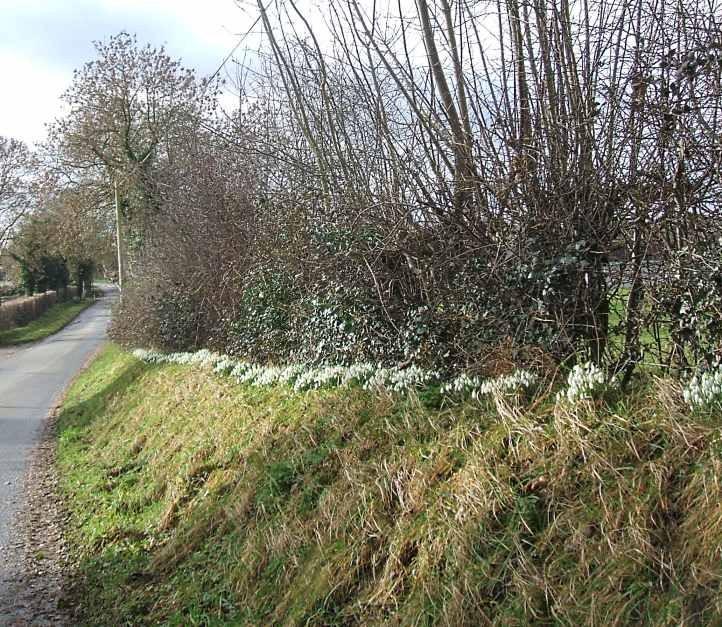
When ready close the window, walk back over the lavender, releasing its aroma, to your seat by the fire. You can feel the small smile of optimism on your face, knowing that the season is turning, fresh existence and growth active in all beings and in your own life.
Turn your thoughts inwards to the midriff of your being. Be aware of your own essence at your centre, your true self. It is as if you are looking through a window again, this opening into your own soul. And within is everything. Happiness, creativity, joy, grief and pain, you can see them all. Looking through the window you can see all this is known by your soul. Yet you are not concerned with what you see, feeling contentment and serenity.
Bring the meditation to a close by bringing your attention again to the painting on the wall of a woman in the stream and man beside her. They are an apparent duality. We perceive much of the world as split into fragments. Notice their freedom. The woman paddling in the stream as if a child. The man watching and waiting to take her hand when ready to step away from splashing amongst the water worn stones. In an instant of realisation you see they are the same person. The divine truth within your soul is there, always playing and waiting to be acknowledged. Thank them for their presence and inspiration. Finish, have a drink and bite to eat.
Melting the Hardest Heart
A smile, a kind word, an unexpected gesture or a beautiful scene, all will melt the hardest heart and are treasures of great value. In these first days of Imbolc the profusion of white delicate snowdrops share their joy of existence, lining our roadsides, hiding under protective whitethorn hedges or as stout shimmering pearls on grassy banks. Life to be appreciated and treasured.
The iron hard earth presented no problem to the determined leaves as they found their way into the light. And the flowers face down to the earth as if in thanks for its nourishment and protection over the winter. Their beauty, enough to soften the hard metal of winter, foretell a transformation.
With emergence of the snowdrops we witness the start of renewed potency in the land and in ourselves.
Once set in motion, sending out roots, there was little doubt that each bulb, the heart of the plant, would support the leaf's rise above the ground. Within the bulb the intention and the plan were robustly established, the design of the potential form comfortably founded. There was no going back once the process began. The first stirring within the bulb knew not to be afraid, trusting that all would be well. And it was.
Reflect on what is emerging in your life, and know when you have faith in a situation, everything will transform. You might like to list what reserves, qualities and facets of your heart you can rely on, what will bring the realisation that there is no need to fear using your potentials, and that they can be invigorated in their growth with the Imbolc energies.
Fingers of daffodils movement meditation
Stiff and erect, daffodil leaves appeared through the bare bleak earth several weeks ago then, as soldiers on parade, abruptly halted. Perhaps there is much activity underground that cannot be seen. You might like to mirror their experience with the following:
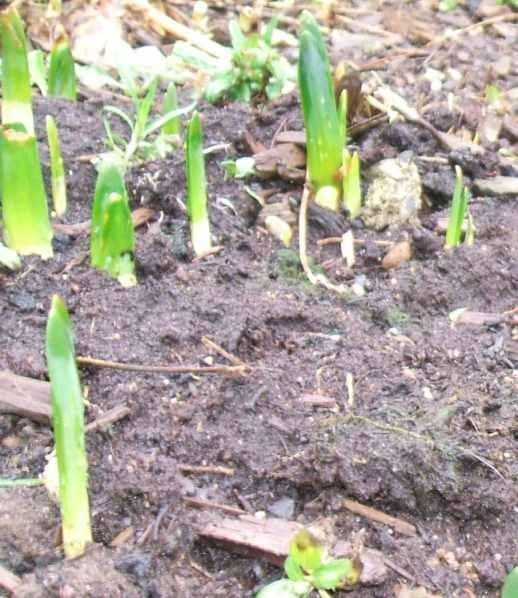
Stand, feet shoulder width apart, knees slightly bent, your arms are by your sides, hands slightly cupped as if holding a huge ball that surrounds your lower torso. Bring your attention to your belly button area. Envision in this area a smaller ball or sphere of condensed energy within the centre of your body.
Take three breaths, with the inhale visualise that this sphere expands slightly and with each exhale that it contracts but never quite goes back to how it was. It is always a little larger with each breath. After the third breath imagine that a root comes of out the sphere and immediately divides into two. The energy of its growth goes down your legs and into the ground beneath you. These roots continue to divide and divide until you have a beautiful web of roots beneath you.
Envisage that these roots can now draw nutrients from their surroundings and these nutritious elements transform into energy that can flow and rise up the roots, up your legs, and into the sphere. Again take three breaths. This time you imagine the inhale as an energy rising up your legs and expanding the sphere just a little. Return to your normal breath and relax. Now envisage that you can feel a pull upwards, as if dancing on the string as a puppet. Bring your arms in front of your belly, palms facing upwards, resting your right hand in the cup of your left, thumbs touching. And this attraction from above draws out of your sphere a shoot that travels upwards, out through your belly button, up in front of your torso. Imagine it resting on your hands then raising your arms slowly upwards rotating your palms outwards at heart level, and finally palms facing skywards above your head. The energy rises high above your heard. This is a unforced gentle movement.
At some point you are aware that you have stretched your furthest comfortably and can now metaphorically break the surface of the soil, by separating your hands and wiggling your fingers. When you do this you are aware of connecting to the universal energy that supports of all life. And you draw this down. Bring your hands together, palms facing each other, fingers pointing upwards and, bending your elbows, drop your arms down so that your hands are in front of your heart, then part them, bringing them to rest, hanging either side of your body. In your imagination, as you are lowering your arms, you are drawing back into the sphere at the centre
of your body the light energy of the sun, moon and stars. Return to normal breathing.
Maintain your attention in the sphere and be aware of the exchange of energy downwards into the earth and back into the sphere. Some of that earth energy you retain and some passes upwards as you breathe with attention out to light above the earth, before drawing that into your sphere. You are now as the daffodil in its first growth of spring, nourished and supported by the earth and preparing to bloom fully in the freedom of the air and light above ground.
There is no need to take this meditation any further now. It is enough to be drawing on your centre sphere and nourishing it, just as the daffodils are with their hidden underground bulbs. There will be plenty of time in the months to come to expand leaves and create blossoms and fruits. And so in your life and its many aspects. The spring is a time for creating these foundations and nourishment for the events of late spring, summer and autumn to unfold.
Yellow air
There are days when we hear the melodic cheeping of small birds in the hedgerows, blackbird turns over leaves for new tasty morsels, and first lambs prance with friends beside proud mothers. Yet much of February is still indoor weather. We sit at the border between winter and summer, and we are solitary, enjoying hours of reading, talking, relaxing.
A week past the time of Brigid crossing the threshold, the drama of the weather invades and fascinates our lives. The white stillness of winter is refreshed by ever-changing wind. We know the sun is there. There is a soft yellow light to the atmosphere, bringing visibility of the advancing white rain as it sweeps across the horizon line, the nearer green ridge of hills disappearing under a grey white curtain.
There are morning, afternoon and evening rainbows, and at this time of year particularly, sun halos.
Frost on the car windscreen this morning gave the hint. Ice crystals remained in the wispy clouds as the sun rose higher in the washed blue sky, and sun halos appeared.
With these eyes
Driving to town through an early morning fog two black crows flew beside me in the adjacent field. We were both heading in the same direction busy about our tasks for the day. Theirs was a journey of purpose. You could tell they had something to do, just as I had, with appointments at the end of our travelling. The car maintained a steady pace and position on the road, so did the birds in the air. It occurred to me that we were both dependent on our eyes to continue this.
As spring energies increase to brighten blue skies and encourage plant growth, we perceive the beauties of earth with our primary sense of sight. Looking outwards we embrace the glories of the landscape. Do we perceive the same beauties looking inwards? Are the eyes the windows of the soul as some say? Have a close look in a mirror. What do you see in your eyes? Certainly the deep blackness of the pupil, but the iris will be coloured, blue, green or hazel probably. Perhaps you see pictures there, imagined or created by patterns on the iris. There may be images of people, animals, birds. You might like to try this in a darkened room with a torch light beneath you chin, casting shadows in unexpected places. A well known saying is 'a friend's eye is a good mirror'. Perhaps you will find some understanding of yourself by looking into another’s eyes.
Of course we cannot see if we do not have light and that is a central philosophical tenet of spirituality.
From the Bible: Matthew 6:22 - The light of the body is the eye: if therefore thine eye be single, thy whole
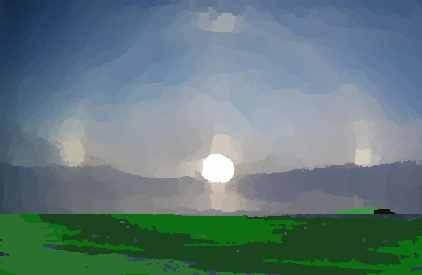
body shall be full of light.
The Irish for eye is Súil. The etymologists tell that this relates back to the Indo-European word for sun, reminding also of the Egyptian links of eye and sun. And things are never straightforward in the poetic Irish language as there is a nuance of meaning for suil meaning anticipate, expect or hope, as in seeing something coming. The English word eye is ancient Germanic in origin.
What are the qualities of light that might be reflections of the qualities of our soul? Photographers and artists, whose creativity is dependent on light, usually describe it as hard or soft. Hard light is that of the clear air of summer, where the emitted radiation from the sun suffers little deflection on its journey to earth. Sunbeams travel in parallel direction. This creates sharp, bright and distinct light and dark areas. The point of transition between light and dark is well-defined, contrasting black and white, no grey here. The shadow is an important component of hard light and the highlight effect is dramatic. Hard light provides defined form and is usually from a single source, a spotlight on the scene.
The moon, reflecting the sun's glare off a million particles on its surface provides softer light. This is also achieved with higher humidity in the atmosphere at dawn and dusk, the sunlight widely reflecting off thousands of drops of watery dew. There are few shadows and where they appear they will be diffused soft hue.
Yet the human soul is a little more complicated than expressing these qualities alone. Lets look at other characteristics and components of light. By shining white light through a prism or crystal colours are neatly lined up in a blend of changing shades. Visible colourless light is part of the electromagnetic spectrum, familiar to us all as the rainbow, red,orange, yellow, green, blue, indigo and violet and then hidden very high energy very hot ultra violet and warm infra reds. Often nowadays the spectrum misses out indigo as a separate colour. Red is at the long wavelength low energy end and violet in the short high energy region. Whereas white is the inclusion of all wavelengths black is, of course, the exclusion of all light.
We are surrounded by colour. Yet that is our human perception. Cats and dogs see mostly grey with a touch of yellow and green. Bees and butterflies can see the ultra-violet .and owls can see in the dark. Insects do not perceive red light. Snails manage to distinguish between light and dark but that is all.
Which colour are you drawn to on the spectrum? It is said that the one you are drawn to is the one you need to introduce into your life at this time as it is lacking. Try colouring in three flower heads. What satisfies you with the subtle shadings and the strong clear colours.
What team of colours suits you?

What else do we learn from plants and their attraction to light.
They live in the shade, do we like to?
Or they live in full sunlight, do we like to?
They live in a bed with other plants and bushes, sharing light, do we like to?
They live in a garden cared for by a gardener, who ensures that each has light available.
Do we like to be cared for?
They live in the wilderness, often struggling for light through an thick undergrowth.
Are we happy alone in a difficult environment?
Apart from colour our other perception is movement. This is not carried out by the eye, but by the brain. There is a rare condition in humans of being unable to see movement – flowing water appears frozen. A car will be there, then here, with no apparent movement between the two places. How we take our 'normal' world for granted.
Of course the best at catching movement is the bird, the being most dependent on its eyes. We can guess much from the basic eye anatomy but we cannot really know what is going on with interpretation in its brain. Their eyes are either side of their head rather than both facing forwards and this must bring disadvantage as well as greater peripheral vision. We are all familiar with a bird bobbing its head up and down, before pecking out of the ground an unseen worm, or catching the tiniest fly. Whereas our eye receives light onto cells called rods and cones in the back of the eye ball, the bird has another group of cells called double cones. These almost certainly gives the bird better colour perception than humans.
Ireland has many place names related to eyes:
Inis Mac Neasáin, a grass clad rocky outcrop island, lies about 2km of the shore of Dublin, near Howth, and is known as Ireland's Eye. With sandy beach, ancient church, seal colony and sea birds it is a little haven visible from the city but apart from the hustle and bustle.
Eye well, Dromore, County Tyrone, is a spring at the base of another rocky outcrop. It issues forth from the base of a hillock under the ruins of a 17th century church. Dip your cloth in the water, wipe the affected eye, then leave the affliction and cloth on the nearby bushes to be dispersed.
Uisneach 'fire eye' hill, where great fires lit on the top in 'ancient times' at Bealtaine, celebrated the May festival.
Death and Rebirth
The Imbolc days challenge us humans. These times of apparent reprieve are punctuated by reminders of our own mortality. The rising temperature and resultant melt can mean that, in areas where the snow has remained for many months, those people and animals who mysteriously disappeared during the winter, having lain hidden under layers of freezing snow, may now be revealed. Their death obviously occurring where we find them. The melt also brings dangers, particularly in mountainous and boggy country. Water soaked land can become a quicksand trap. Death not only lurks in the dark shadows of winter.
Statistics show that spring is our most likely season for death. Yes, death and rebirth go hand in hand. The vigour of spring energies can be too much to manage and for some of us it is time to get off the wheel of life on earth.
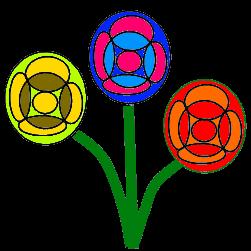
Hopeful transitions are all around us. The hours of daylight lengthen, the air is warming. There is longedfor enthusiastic spurts of growth by young shoots on bare brown branches. Amorous frogs return to ancestral ponds, clear jelly spawn with black dot babies the reward for all their activity.
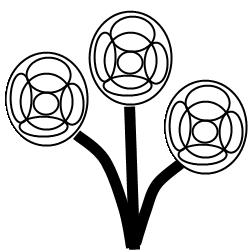
Everywhere there are signs of rebirth and renewal after long dark adagio nights of winter. The sun is moving northwards, heading in our direction, and is higher in the sky every day. Early morning frosts clear quickly, yet there is an uncertainty with the weather. A bright sunny spring morning can quickly turn to misty afternoon of heavy rain. The very phrase spring evokes water rising up and gushing out onto the land with youthful vitality. There is promise in the expectation that after the long sleep (another metaphor for death) of winter, we and nature will miraculously awaken again. The language of military action enters our literature as we talk of defeating winter. There is a need to believe that winter will be subjugated by the arrival of spring. For winter is seen as 'bad' and spring 'good'. The old fight of the light and dark forces of nature.
The understanding from nature is that we pass from winter to spring and we appear to be reborn from death. Interestingly, we do not actually continue the cycle by reversing and unreeling it. If we did, we would start with death, go to old age, maturity and end up as a new born babe.
It is as if in Spring we jump from one cycle to the next missing out stages of maturity and youth we had previously regarded as essential. It is not a winding and unwinding of the cycles but a hop between each. Herein lies much opportunity for philosophical discussion.
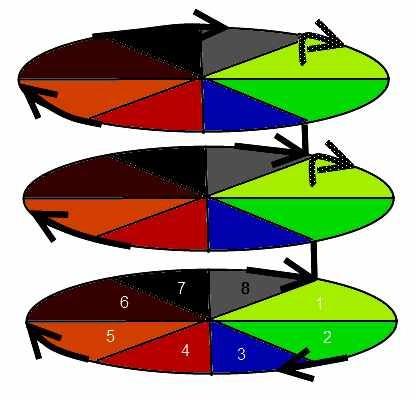
The major religions of the world are split on the understanding of reincarnation and rebirth.
Firstly, what is death? Physically it is a perpetual process. Our bodies are continually changing, new cells are formed whilst others lose their purpose. And so we are not the same person from one day to the next or from one moment to the next.
Many do not teach re-incarnation for they believe in the continual flow of energies changing and reinventing life.
Yet there comes an occasion when the bodies cells all close down within a short space of time. What we recognise as death.
Word origins are very useful in understanding the different concepts. Reincarnation comes from the Latin meaning 're-entering the flesh', suggesting that a being has been in flesh and returns to flesh. Rebirth on the other hand does not necessarily infer that a particular energy or soul remains intact as a 'being', but that on death our energies return to a general pool that is then the source of new beings.
Discussing rebirth necessarily involves consideration of the concept of the soul. Whether the soul exists at all and if it does, where lies its origin and where does it return to at death. Thankfully it is not possible to prove or disprove any point. It would be true to say there are as many opinions about the continuation of life after death as there are people on the planet. And this opens the possibilities, using your own intuition, for you to ask your own soul whether it exists. You might like to do this in meditation.
Virus Cycle of Life and Love
And what comes to our ears, amongst auspicious chirrups as bird couples consider DIY projects at possible nesting sites? The sounds of human misery me – snuffles of blocked dripping noses, growly voices, hot / cold shivering, and throaty, chesty coughs. Springtime activates the cold and flu virus challenging our immune system. Indeed the very word virus has an origin in the Latin for poison.
What follows is metaphorical and simplistic but maybe there is some wisdom to share in exploring the virus.
These miniscule, elementary pathogens exist in every ecosystem on earth and are ancient. Pathogen? Again a fascinating origin, from the Greek language, meaning 'I give birth to suffering / passion'. Disease
and emotions were linked in this word around the early 1900s. Love the virus.
Virus are amazing 'beings' on the edge of existence, and well worth closer examination. Their vast diversity exists on the liminal, transitional zones expressing some facets of 'life' and some of chemical organic structure. The virus reproductive life cycle is unlike our own as it requires a 'host' and does not grow by cell division. It needs to live with another being, but more specifically with a particular being that suits its design. Hence the virus seeks out a possible host and attaches itself. Does this sound familiar?
Romantic balladeers have been singing for centuries about that longing of 'looking for someone to love', the yearning of wanting to touch and bind ourselves to another human being.
And then a virus penetrates inside the chosen host. And here we have the next learning of wisdom from the virus. How often do we say someone gets under our skin? They bother and annoy us.
And yet one of the most popular love songs starts 'I've got you under my skin, deep in the very heart of me, so deep in my heart, that you're really a part of me'.
Yes, that's the virus – regarded as deep irritation or an attachment that progresses to deeply experienced love.
Thus we move to stage three. The virus is inside the host and can now commence replication. The host assists in the virus survival, as the virus uses the components of the host cell. And thus your lover has indeed got under your skin, and you start a process of growth together.
And onto our next popular romantic ditty – 'Love changes everything'. Indeed we all know that love will never let you be the same again. And so it is with the virus as it uses the components of the host cell to assemble new viruses.
In the physical world the host cell has two possibilities.
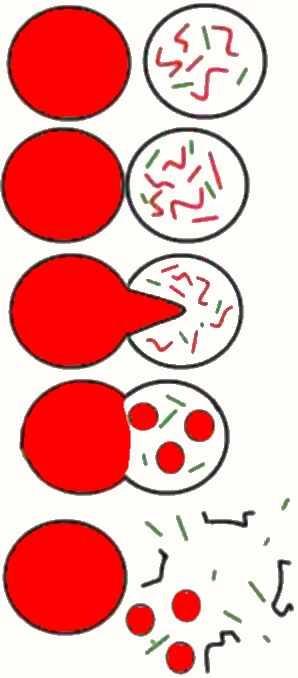
It can stop the virus by committing suicide or it can succumb to the virus taking some of its components. Some would liken the host cell to being a victim of the virus, and we human beings know we do not have to be victims. And so with love. When somebody gets under our skin we can recognise and stop the process. We can all say 'No – go away'.
Unlike the host cell we do not have to go so far as to commit suicide for the human being can say to another human being 'You are debilitating me, and occupying too much of my existence. I don't want you in my life'.
The virus also has two possibilities. Having used the components of the host cell to create hundreds of new virus, these can either totally break down the walls of the host cell, thus destroying it, or bud off and be released through the cell wall, leaving the host still intact.
The metaphor is obvious. We know, and may have experienced in our own lives, love that is devastating and destroys a part of us, or love that enters our lives, changes them, and then moves on in a mutual separation.
This diagram makes no attempt to be biologically correct but hopefully conveys some of the drama and exchange between the virus and host.
And so, as you cough and splutter, shiver and shake with the common cold or a touch of flu this spring, you might like to review what the virus is teaching you about your love relationships.
There are many songs and verses likening love to the common cold, how it can be caught, and how it can be overwhelming. Now we can review some of the stages of this affinity, consider whether you are the virus or the host, and with this understanding comes ideas for ways forward.
P.S. Writing this it never occurred to me that there would be a pandemic in the following years. NJ.
